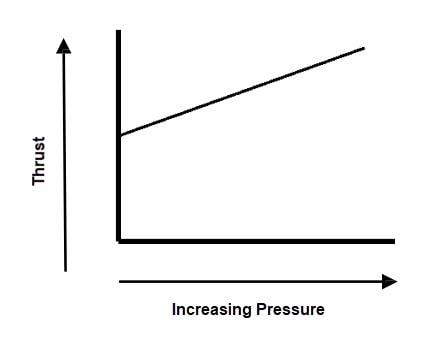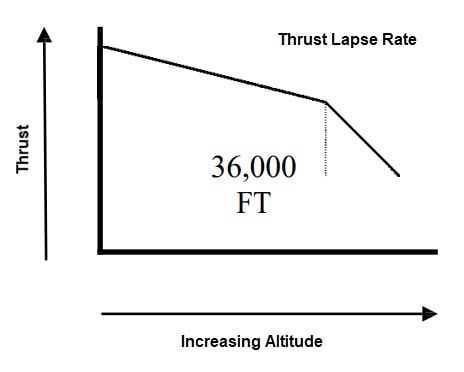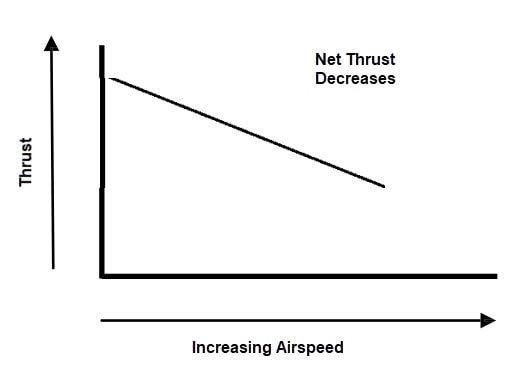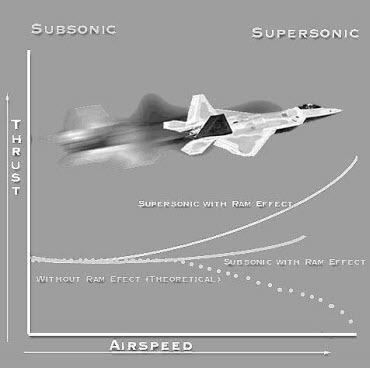# FACTORS AFFECTING THRUST:
Table of Contents:
- What Are The Factors Affecting Thrust Of A Gas Turbine Engine?
- Factors Affecting Thrust – Air Density
- Factors Affecting Thrust – Altitude
- Factors Affecting Thrust – Airspeed
- Factors Affecting Thrust – Ram Effect
- Factors Affecting Thrust – Engine RPM
What Are The Factors Affecting Thrust Of A Gas Turbine Engine?
The factors affecting thrust of a gas turbine engine include air density, altitude, airspeed, ram effect and engine RPM. The effect of these factors is not restricted to any particular gas turbine engine; although a certain engine may be able to compensate for an effect better than another.
1. Factors Affecting Thrust – Air Density:
Density is the mass of a substance per unit of its volume. According to the thrust equation, if the mass of airflow increases, thrust will increase. If the density of air increases, mass will increase, and therefore thrust will increase. As an aircraft operates at various altitudes and climates, the ambient air temperature and pressure will vary. These factors will affect the density of the air entering the engine, and as a result, will affect thrust.
As air temperature increases, air molecules tend to move apart. This results in a density decrease, and a resultant decrease in thrust. An engine operating in the warm temperatures near the equator will produce less thrust than an engine operating in the cold of Alaska. Thrust may vary as much as 20 percent from standard rated thrust on a hot or cold day.

As air pressure increases, air molecules tend to move closer together. This results in an increase in density, and therefore, thrust increases. For example, an aircraft that flies through the low-pressure eye of a hurricane will produce less thrust than an aircraft operating at normal ambient pressures.

2. Factors Affecting Thrust – Altitude:
As an aircraft climbs, pressure and temperature will normally drop. From the previous discussion, thrust will decrease with a pressure decrease, and thrust will increase with a temperature decrease. With an increase in altitude, however, the rate of thrust decreases because a pressure drop is greater than the thrust increase resulting from a temperature drop. This means an engine will produce less thrust as it increases in altitude.
At approximately 36,000 feet (beginning of the isothermal layer), temperature stabilizes. As a result, temperature will no longer offset the density decrease due to pressure. Therefore, thrust decreases more rapidly. This altitude is also known as the optimum cruise level. At this altitude, thrust available plus low fuel flow and diminished drag combine to provide optimum performance for many engines.

3. Factors Affecting Thrust – Airspeed:
In the thrust equation, the difference between the inlet and exhaust velocities plays a major role in determining thrust available. As the inlet velocity (v initial) approaches the magnitude of the exhaust velocity (v final), thrust is reduced. Therefore, if the mass of air and fuel is held constant, thrust will decrease as airspeed increases. This decrease in thrust due to an increase in airspeed is theoretical.

4. Factors Affecting Thrust – Ram Effect:
If we only consider the change in airflow velocity in the thrust equation, then thrust decreases with an increase in airspeed. Remember, that the thrust equation consists of two variables: mass (m) and acceleration (v final – v initial). As mentioned, the difference between inlet and exhaust velocities decreases as the aircraft increases speed. However, more and more air is being rammed into the inlet, increasing the mass and pressure of inlet air. This offsets the decrease in acceleration and results in a neutral effect or slight increase in thrust at subsonic airspeeds.
This is due to the compressibility of airflow as velocity increases toward supersonic. As airflow becomes compressible, mass due to ram effect increases at an increasing rate. Ram effect is especially important to high performance aircraft due to the exceptionally high mass airflow that occur at supersonic speeds. This results in a significant increase in overall thrust due to ram effect at supersonic speeds. For many high-performance fighter aircraft, ram effect allows excellent high altitude performance, although air density is low.

5. Factors Affecting Thrust – Engine RPM:
One of the most obvious factors that affects the thrust output is the rotational speed of the engine. With an increase in RPM, there is an increase in thrust. However, at low RPM there is very little increase in thrust with an increase in throttle. At higher rates of revolution, a small increase in throttle setting will produce a large increase in thrust. At the lower settings, fuel consumption is high for the amount of thrust produced. For this reason, gas turbine engines are normally operated at near their maximum RPM.

Content is really beneficial.